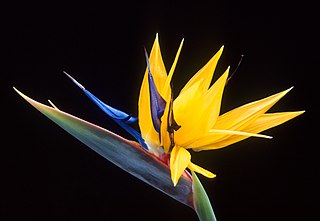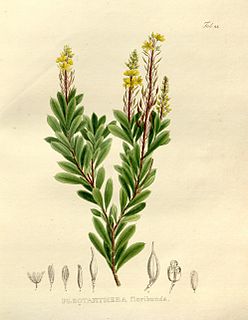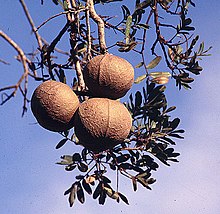
Royal Botanic Gardens, Kew is a non-departmental public body in the United Kingdom sponsored by the Department for Environment, Food and Rural Affairs. An internationally important botanical research and education institution, it employs 1,100 staff. Its board of trustees is chaired by Dame Amelia Fawcett.

Strelitzia is a genus of five species of perennial plants, native to South Africa. It belongs to the plant family Strelitziaceae. The genus is named after Queen Charlotte of the United Kingdom. A common name of the genus is bird of paradise flower/plant, because of a resemblance of its flowers to birds-of-paradise. In South Africa, it is commonly known as a crane flower and is featured on the reverse of the 50-cent coin. It is the floral emblem of the City of Los Angeles; two of the species, S. nicolai and S. reginae, are frequently grown as houseplants.

Goldenrod is a common name for many species of flowering plants in the sunflower family, Asteraceae, commonly in reference to the genus Solidago.

Knightia is a small genus of the family Proteaceae endemic to New Zealand, named in honor of Thomas Andrew Knight. One extant species, K. excelsa (rewarewa) is found in New Zealand. Two further Knightia species are found in New Caledonia, although they were placed in the genus Eucarpha by Lawrie Johnson and Barbara Briggs in their influential 1975 monograph "On the Proteaceae: the evolution and classification of a southern family", a placement supported in a 2006 classification of the Proteaceae. A fossil species from upper Miocene deposits in Kaikorai has been described as Knightia oblonga. Knightia has been placed in the tribe Roupaleae of the subfamily Grevilleoideae.

Selenicereus, sometimes known as moonlight cactus, is a genus of epiphytic, lithophytic, and terrestrial cacti, found in Mexico, Central America, the Caribbean and northern South America. The term night-blooming cereus is also sometimes used, but this is also used for many night-blooming cacti, including Epiphyllum and Peniocereus. In 2017, the genus Hylocereus was brought into synonymy with Selenicereus. A number of species of Selenicereus produce fruit that is eaten. The fruit, known as pitaya or pitahaya in Spanish or as dragon fruit, may be collected from the wild or the plants may be cultivated.

Lumnitzera is an Indo-West Pacific mangrove genus in the family Combretaceae. An English common name is black mangrove. Lumnitzera, named after the German botanist, Stephan Lumnitzer (1750-1806), occurs in mangroves from East Africa to the Western Pacific, and northern Australia.
The World Checklist of Selected Plant Families is an "international collaborative programme that provides the latest peer reviewed and published opinions on the accepted scientific names and synonyms of selected plant families." Maintained by the Royal Botanic Gardens, Kew, it is available online, allowing searches for the names of families, genera and species, as well as the ability to create checklists.
Hornschuchia is a genus of flowering plants in the custard apple and soursop family Annonaceae, with all species native to South America and in eastern Brazil. It is within the Bocageeae tribe.
Hallia is a taxonomic synonym that may refer to:
Bocagea is a genus of plants in the family Annonaceae. It comprises four species distributed in Brazil. Augustin Saint-Hilaire the French botanist who first formally described the genus named it after Josephi Mariae de Souza du Bocage, who he said beautifully translated a poem about flowers into Portuguese and illustrated it.

Anchietea is a genus of flowering plants in the violet family Violaceae, with six accepted species, found in tropical South America.
Gymnospora is a genus of plants in the milkwort family (Polygalaceae) which is endemic to Brazil. It was first described as a subgenus of Polygala by Robert Chodat in 1891. It was separated into its own genera in 2013. Their flowers are 6 to 10 millimetres long and its pedicels are 2 to 8 millimetres long.

Eriocapitella tomentosa, a species of flowering plant in the buttercup family Ranunculaceae, is native to Asia. The specific epithet tomentosa means "thickly matted with hairs, tomentum (padding)". In Chinese, a common name is da huo cao (大火草), which means "big fire grass" or "great fireweed".

Luxemburgia is a genus of flowering plants belonging to the family Ochnaceae.
Metrodorea is a genus of flowering plants belonging to the family Rutaceae.
Monteiroa is a genus of flowering plants belonging to the family Malvaceae.

Salvertia is a monotypic genus of flowering plants belonging to the family Vochysiaceae. The only species is Salvertia convallariodora.
Zanthoxyloideae is a subfamily of the family Rutaceae.

Annona sylvatica is a species of flowering plant in the family Annonaceae, native to Brazil. Its plentiful fruit is edible and is regularly gathered in the wild by locals, and it is occasionally cultivated. It is considered a good species to use for reforestry projects, as it is very fast growing when young.
Eucarpha deplanchei is a species of flowering plant in the family Proteaceae, native to New Caledonia. It was first described in 1865 as Knightia deplanchei, the name used by Plants of the World Online as of April 2022.











